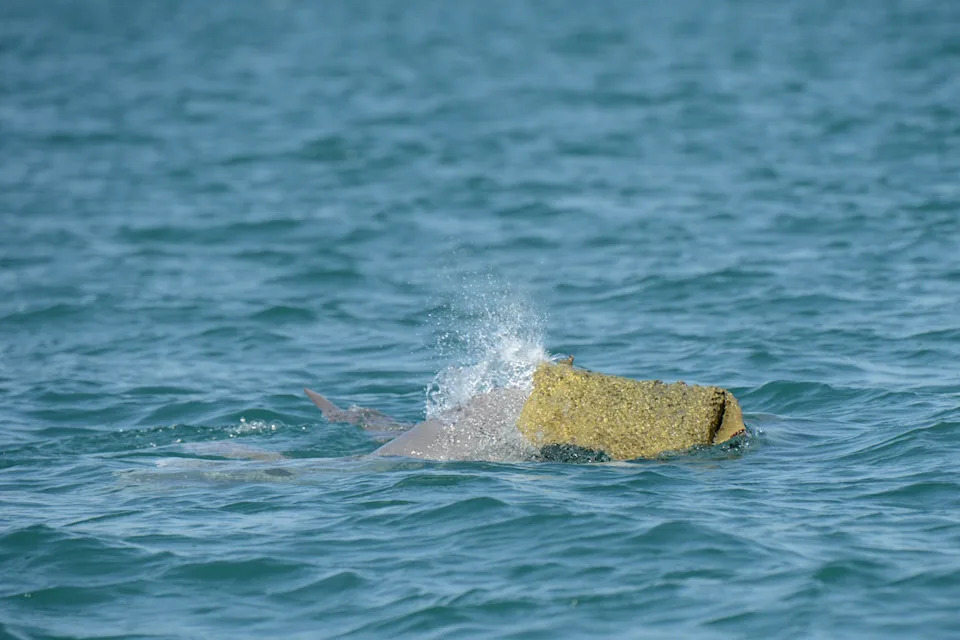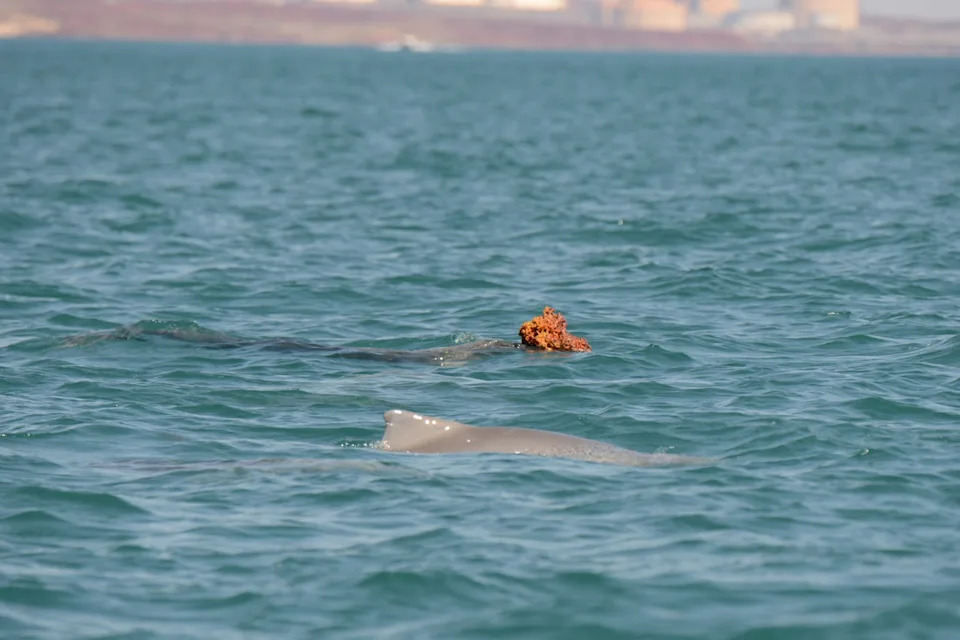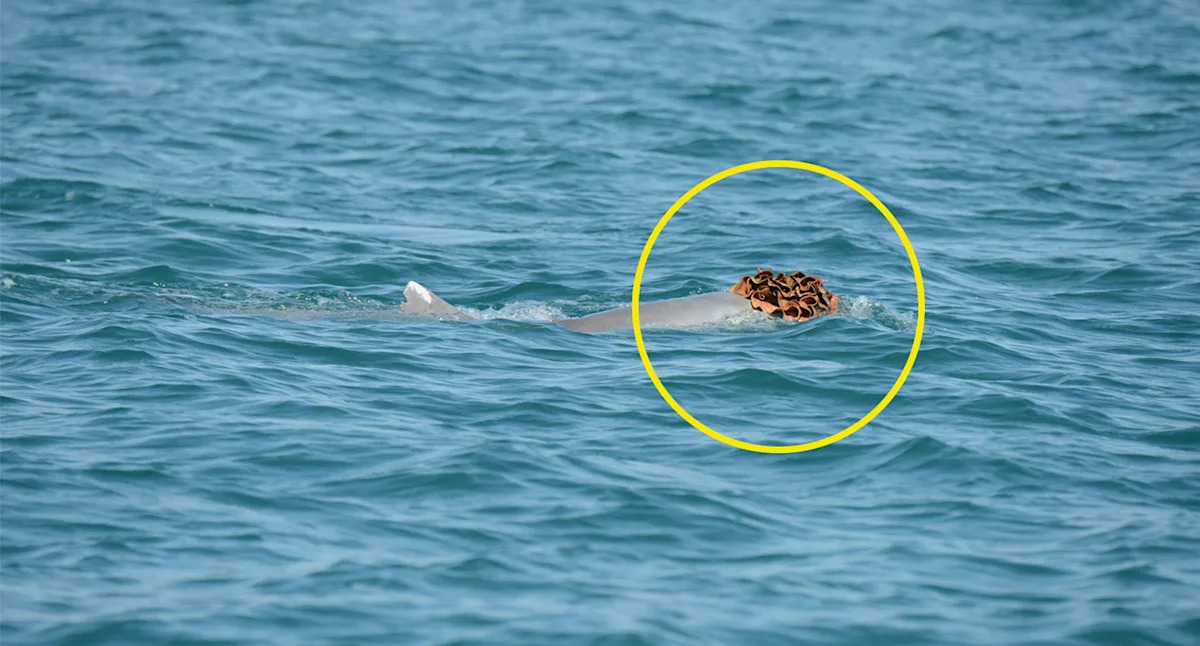Mesmerising photos capturing native Australian dolphins donning sea sponges and other stunning headwear have been shared showing an ultra-rare marine courtship act rarely seen by people.
The shots, which recently resurfaced online and sparked a wave of fascination, were captured a few years ago in the Dampier Archipelago’s Flying Foam Passage, off Western Australia’s rugged Burrup Peninsula, by scientists from the Department of Biodiversity, Conservation and Attractions (DBCA).
The images show male dolphins engaging in an extraordinary and rarely seen courtship ritual — collecting and presenting sea sponges to potential mates, almost like romantic gifts. In some cases, they even balance the sponges on their heads or snouts.
For Senior Research Scientist Holly Raudino, from DBCA’s Marine Science Program, the renewed attention has been a welcome reminder of just how special and fragile this little-known species is.

The incredible images were taken in the Dampier Archipelago in the Flying Foam Passage, between Angel Island and Dolphin Island. Source: WA Parks and Wildlife Service
“There’s renewed interest in the species because they’ve actually been uplisted to vulnerable under the EPBC Act,” Dr Raudino told Yahoo News Australia. “People are concerned about their population status and them being threatened.”
The dolphins in the photos are Australian humpback dolphins — a coastal species found only in northern Australian waters, and one of the few known to display such unusual, social behaviour.
Unique dolphin courtship only ‘seen in a handful of places’
“It’s quite unique,” Dr Raudino said of the behaviour. “It’s only been seen in a handful of places — two in the Pilbara, which are Dampier and Exmouth, and also up in the Kimberley. I haven’t even seen it that many times, and I’ve been out there a lot.”
While other dolphins, like the bottlenose population in Shark Bay, use sea sponges as tools to protect their snouts while foraging, humpback dolphins appear to do it for love. “This has been shown to be just the males using it, so it’s definitely in a sexual context,” she said.
Incredibly, the behaviour has only been documented a few times worldwide. When Dr Raudino and her team first witnessed it, they were thrilled. “We were very excited,” she said. “There are videos, which we usually turn the sound down on because we’re all squealing and exclaiming.”
Researchers were actually in the area on a different mission at the time, collecting DNA samples from the dolphins’ blow to study genetics, when they stumbled upon the display. “Then, incidentally, we observed them doing this behaviour,” Dr Raudino said.

The mammals are known to present the sponges to prospective mates as ‘bouquets’. Source: Source: WA Parks and Wildlife Service
More funding needed to help understand little-known species
Now, with the species officially listed as vulnerable, she’s calling for more funding to help researchers better understand and protect them. “We’d need to do a dedicated study,” she said. “We’d probably have to survey where the sponges are and look at how that overlaps with dolphin sightings. That would be a great project — we’d definitely need more funding to do that.”
Understanding these quirks of behaviour, she said, is key to ensuring the species survives. “They’re endemic to Australia and were only fairly recently described — the taxonomy was only resolved about 10 years ago,” Dr Raudino said. “If we don’t look into it more, we don’t know what we’re losing.”
Dolphins’ astonishing knack for creativity
Dolphins are renowned for their problem-solving skills and complex social interactions. They can work together to herd fish, coordinate hunting strategies, and even protect weaker members of their pod from predators. Some dolphins have been observed using sponges as tools to protect their snouts while foraging along the seafloor, a behaviour that’s passed down from mother to calf, showing evidence of culture and learning.
Their intelligence also extends to communication. Dolphins use a variety of clicks, whistles and body movements to convey messages, and some species even have signature “names” — unique whistles that identify individual dolphins within a pod.
They’ve been known to cooperate with humans in certain tasks, respond to trained commands, and display playful curiosity with objects, boats and even other animals, revealing a remarkable capacity for learning, adaptation, and social complexity.
Do you have a story tip? Email: newsroomau@yahoonews.com.
You can also follow us on Facebook, Instagram, TikTok, Twitter and YouTube.

